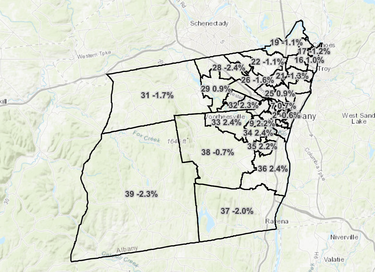Redistricting Commission adopts map and schedules final public hearing
ALBANY COUNTY — The Albany County Redistricting Commission has adopted its final map and will hold a public hearing for it on Aug. 5 at 4:30 p.m. in the Harold L. Joyce County Office Building, with the option to attend remotely.
After the hearing, the commission will send its map to the Albany County Legislature for approval.
The map adopted by the commission on July 21 features significant changes from its June draft, primarily in the Guilderland area.
In the adopted map, District 29, represented by Mark Grimm, has shifted south, incorporating the Albany Country Club and Nott Road Town Park, and losing everything north of Fuller Station Road, as well as some of its eastern portion around Fusco Town Park.
District 28, represented by Dennis Feeney, has taken over those northern portions while losing its own northeastern section past the CSX railway.
District 30, represented by Dustin Reidy, loses a lot of area around the Pine Bush and Prospect Hill Cemetery while picking up small spots in the west and south.
District 33, represented by William Reinhardt, has gained significant area to the east, now extending to Route 85.
District 38, represented by Victoria Plotsky, is largely unchanged.
In the Hilltowns, District 39, represented by Chris Smith, has given what little it had of Knox back to District 31, represented by Jeff Perlee, so that District 31 has all of Knox while District 39 retains all of the other three Hilltowns — Westerlo, Rensselaerville, and Berne — and a portion of Greenville.


